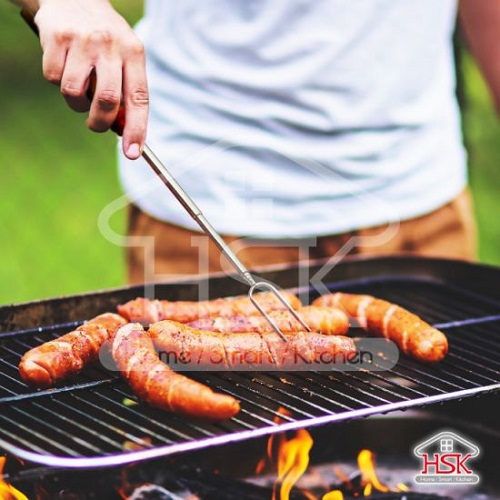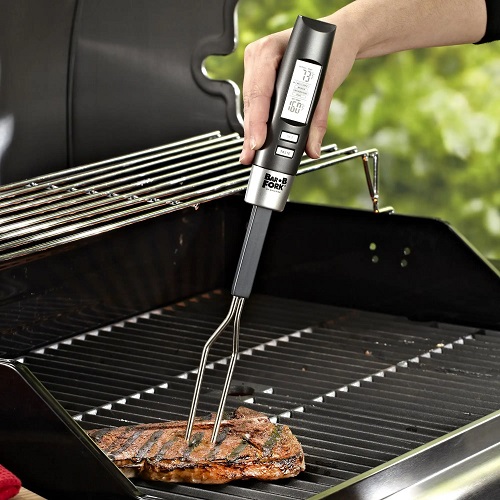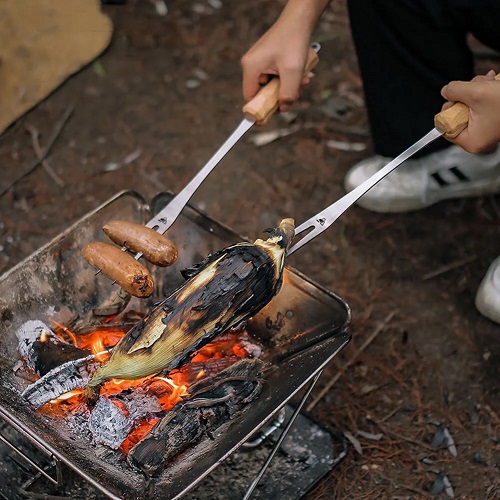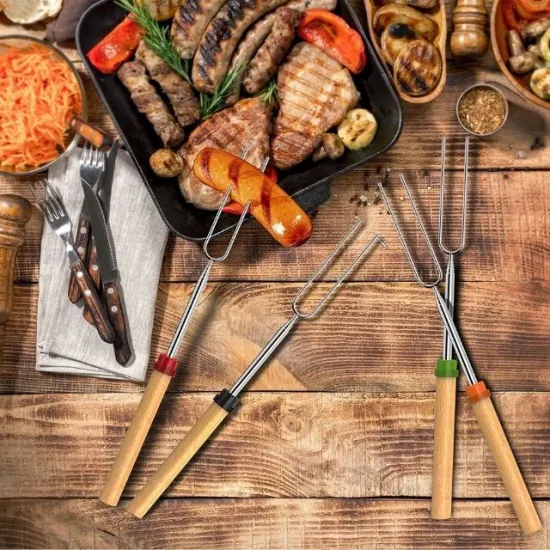Unleashing the Hidden Talents of Your Barbecue Fork
Discover the untapped potential of your barbecue fork! From grilling perfection to marshmallow roasting and creative food presentation, this versatile tool goes beyond its traditional role, becoming an indispensable companion in both outdoor cooking adventures and various kitchen tasks.
Unlocking Culinary Creativity: The Many Uses of a Barbecue Fork
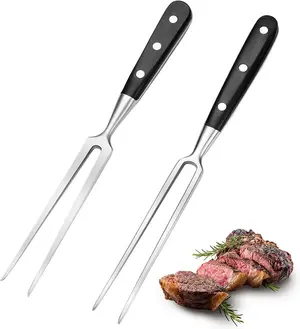
The barbecue fork's lineage can be traced back to ancient cooking methods, where our ancestors roasted meat over open flames. Early iterations were rudimentary, often consisting of sharpened sticks used to pierce and turn meat. As culinary techniques advanced, so did the barbecue fork. Today, modern designs feature elongated handles, sturdy tines, and materials like stainless steel, ensuring durability and ease of use.
A barbecue fork is more than just a tool to flip meat. Its versatility extends to various grilling techniques. The tines can be used to pierce and marinate meat, ensuring flavor permeates every inch. Additionally, a barbecue fork is invaluable for checking the doneness of meat by piercing and assessing the juices. Skewering vegetables or kebabs becomes a breeze, showcasing the fork's ability to handle diverse grilling needs.
Tips for Using a Barbecue Fork Effectively
Mastering the use of a barbecue fork requires finesse and skill. Here are some tips to elevate your grilling game:
- Use the Right Fork: Ensure your fork is appropriate for the task at hand, considering the type and size of meat you are grilling.
- Pierce with Precision: When piercing meat, do so at an angle to avoid excessive punctures, preserving the juices within.
- Rotate, Don’t Stab: Use a gentle rotating motion to turn meat, preventing unnecessary tearing and ensuring even cooking.
- Leverage the Handle: The handle is your control center. Utilize it for precise maneuvers, keeping your hands safe from the heat.
Cleaning and Maintenance Tips for Your Barbecue Fork
A well-maintained barbecue fork is the unsung hero of every successful grilling session. Whether you're a seasoned grill master or a novice, understanding how to clean and care for your barbecue fork is crucial for ensuring its longevity and optimal performance. Here are some essential tips to keep your barbecue fork in top-notch condition:
1. Immediate Post-Grilling Clean-Up: After you've grilled your delicious feast, don't let the residue linger on your barbecue fork. Immediate cleaning is key to preventing stubborn buildup. While the fork is still warm, use a grill brush or a dedicated fork-cleaning tool to scrub off any remaining food particles.
2. Handwashing vs. Dishwasher: While many barbecue forks are dishwasher-safe, handwashing is often recommended for thorough cleaning and to extend the life of your fork. Rinse the fork under warm water to remove surface debris, and use a mild dish soap and a sponge or brush to clean between the tines and around the handle.
3. Avoid Harsh Chemicals: Resist the temptation to use harsh cleaning chemicals or abrasives on your barbecue fork. These can damage the fork's finish, compromise its structural integrity, and potentially transfer unwanted flavors to your food. Stick to gentle, grill-safe cleaning solutions.
4. Regular Inspection: Periodically inspect your barbecue fork for any signs of wear and tear. Check for bent or misaligned tines, loose handles, or any other structural issues. Addressing these concerns promptly can prevent further damage and ensure the fork's continued effectiveness.
5. Stainless Steel Maintenance: Many barbecue forks are crafted from stainless steel due to its durability and resistance to corrosion. To maintain its shine, wipe down the fork with a damp cloth after cleaning. If you notice any discoloration, a mixture of baking soda and water can help restore its original luster. Make sure to rinse thoroughly and dry completely.
6. Avoiding Rust: Even stainless steel can be susceptible to rust if not properly cared for. Ensure your barbecue fork is completely dry before storing it. If you notice any signs of rust, use a mixture of vinegar and baking soda or a rust-removing solution to gently scrub the affected areas. Rinse well and dry thoroughly.
7. Storage Matters: Store your barbecue fork in a cool, dry place away from direct sunlight. If possible, hang it or keep it in a utensil holder to prevent contact with other metal objects that might cause scratches. Proper storage not only maintains its cleanliness but also prevents unnecessary wear.
8. Handle with Care: Handle your barbecue fork with care, especially when using it to pierce and turn heavier cuts of meat. Avoid excessive force that could bend or stress the tines. If the fork has a wooden handle, be mindful of moisture, as prolonged exposure can lead to warping or cracking.
What is a BBQ fork for?
A BBQ fork, also known as a grilling fork or barbecue fork, is a specialized utensil designed for use in outdoor cooking, particularly on a barbecue or grill. This tool serves several essential purposes in the grilling process:
1. Turning and Flipping: The primary function of a BBQ fork is to turn and flip food items on the grill. Whether you're grilling burgers, steaks, chicken, or vegetables, the fork allows you to lift, rotate, and reposition the items to ensure even cooking on all sides.
2. Piercing and Checking Doneness: The fork's tines are designed to pierce through the meat, allowing you to check its internal temperature or assess its doneness. This is especially useful for thicker cuts of meat where accurate temperature monitoring is crucial to achieving the desired level of doneness.
3. Marinating: Many BBQ forks are equipped with long, sturdy tines that can be used to pierce meats for marination. By creating small channels in the meat, marinades can penetrate more effectively, infusing flavor throughout the entire piece.
4. Handling Larger Cuts of Meat: When dealing with large cuts of meat, such as roasts or whole poultry, a BBQ fork provides a stable and secure way to handle the meat during the grilling process. It helps prevent slippage and allows for easier maneuvering.
5. Skewering and Grilling Kebabs: Some BBQ forks come with additional features like prongs or a flat surface, making them ideal for skewering and grilling kebabs or shish kabobs. This adds versatility to the fork, allowing it to handle a variety of grilling tasks.
What utensils are used in BBQ?
Grilling and barbecue require a specific set of utensils to ensure a smooth and successful cooking experience. Here's a list of essential utensils used in BBQ:
1. Grill Brush: A grill brush with sturdy bristles is essential for cleaning the grates before and after cooking. Regular cleaning prevents residue buildup, ensuring a clean cooking surface.
2. Tongs: Long-handled tongs are versatile tools for flipping, turning, and transferring food on the grill. They provide a good grip and keep your hands at a safe distance from the heat.
3. Spatula: A wide, flat spatula is ideal for flipping burgers, fish, and delicate items. Look for one with a long handle to prevent reaching over the hot grates.
4. BBQ Fork: As discussed earlier, a BBQ fork is used for turning, flipping, and checking the doneness of meats. It's a versatile tool with prongs designed for various grilling tasks.
5. Grill Tongs with a Locking Mechanism: Some tongs come with a locking mechanism, allowing for easy storage and handling. This feature is convenient for keeping your utensils compact when not in use.
6. Basting Brush: A basting brush is used for applying marinades, sauces, or oil to food during the grilling process. Look for heat-resistant bristles to avoid melting.
7. Grill Basket: Ideal for grilling small or delicate items like vegetables and seafood, a grill basket prevents them from falling through the grates while allowing for even cooking.
8. Grill Gloves: Heat-resistant gloves protect your hands when handling hot grates, adjusting vents, or placing and removing food from the grill. They provide better dexterity than traditional oven mitts.
What is the difference between dinner fork and grille fork?
The terms "dinner fork" and "grill fork" may sometimes be used interchangeably, but they typically refer to different types of forks designed for different purposes. Here are the general distinctions between a dinner fork and a grill fork:
Dinner Fork:
- Design: A dinner fork is a standard piece of flatware commonly used in formal and informal dining settings. It has a relatively straightforward design with four evenly spaced tines.
- Size: Dinner forks are typically smaller than their grill fork counterparts. They are designed for general dining purposes and are part of a set of flatware used for eating meals at a dining table.
- Function: Dinner forks are intended for use during meals to pick up and eat a variety of foods, including salads, main courses, and side dishes. They are not specifically designed for use in cooking or grilling.
Grill Fork:
- Design: A grill fork, also known as a barbecue fork or grilling fork, is specifically designed for use during outdoor cooking on a barbecue or grill. It often has a longer handle to provide a safe distance from the heat and sturdy tines suitable for piercing and flipping meat.
- Size: Grill forks tend to have longer handles compared to dinner forks. The extended length is practical for reaching over the hot grates of a grill without risking burns.
- Function: The primary function of a grill fork is to assist in grilling tasks, such as turning and flipping meat, checking the doneness of cuts, and handling larger pieces of food. Some grill forks may also have features like a built-in thermometer or prongs for skewering kebabs.
What else can a barbecue fork be used for?
A barbecue fork, with its versatile design and sturdy construction, can be employed for various tasks beyond its primary role in grilling. Here are several alternative uses for a barbecue fork:
1. Roasting Marshmallows: The long tines of a barbecue fork make it an excellent tool for roasting marshmallows over an open flame. It provides a safe and controlled way to achieve that perfect golden brown exterior.
2. Shredding Meat: After grilling or roasting, use the fork to shred cooked meat, such as pulled pork or chicken. The fork's prongs can effectively tear the meat into smaller, bite-sized pieces.
3. Serving: The barbecue fork can double as a serving utensil, especially for larger cuts of meat. Use it to transfer grilled steaks, roasts, or whole poultry from the grill to the serving platter with precision.
4. Piercing Holes in Baked Potatoes: When baking potatoes on the grill, a barbecue fork can be used to pierce holes in the potatoes. This allows steam to escape and helps the potatoes cook evenly.
5. Testing Cake Doneness: If you're baking a cake on the grill or using an outdoor oven, the barbecue fork can serve as a makeshift cake tester. Insert it into the center of the cake; if it comes out clean, the cake is done.
6. Arranging Charcoal: Use the fork to arrange and spread charcoal in a grill or smoker. This ensures even heat distribution during the cooking process.
7. Mixing Ingredients: The fork's long handle and sturdy design make it suitable for mixing ingredients in large bowls or pots. Whether you're preparing marinades, dressings, or batters, the fork can handle the task effectively.
8. Skewering Fruits for Grilling: Thread fruits onto the fork for grilling. Pineapple, peaches, and other fruits caramelize beautifully when grilled, and the fork provides an easy way to handle and turn them.
9. Decorative Food Presentation: Use the fork to arrange and present food on a platter in an aesthetically pleasing manner. It can be a handy tool for positioning pieces of meat, vegetables, or other grilled items.
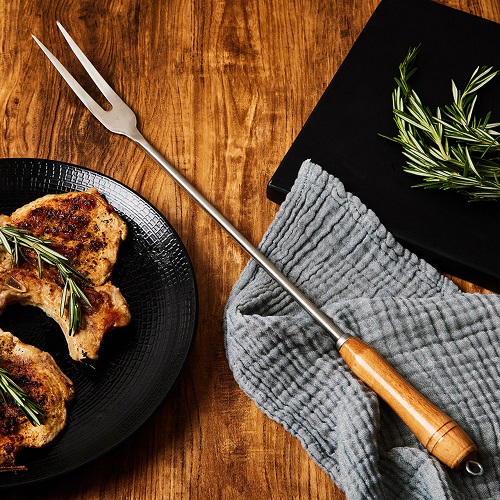
The barbecue fork is a versatile tool that extends beyond its primary role in grilling. With its long handle and sturdy design, it finds utility in various culinary tasks. Apart from turning and flipping meat on the grill, a barbecue fork can be used for roasting marshmallows, shredding cooked meat, serving larger cuts, piercing potatoes, testing cake doneness, arranging charcoal, mixing ingredients, skewering fruits, presenting food decoratively, handling corn on the cob, breaking up ice, and stabilizing kebabs for cutting. Its multifunctional nature makes it an indispensable tool not only for outdoor cooking enthusiasts but also for various kitchen activities, enhancing its value in both grilling and general culinary tasks.

